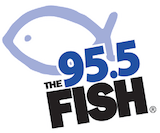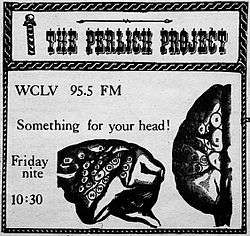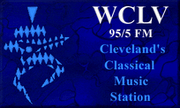WFHM-FM
WFHM-FM (95.5 FM) – branded 95.5 The Fish – is a commercial Christian contemporary radio station licensed to Cleveland, Ohio. Owned by the Salem Media Group, the station serves Greater Cleveland and much of surrounding Northeast Ohio. The WFHM-FM studios are located in the Cleveland suburb of Independence, while the station transmitter resides in Warrensville Heights. Besides a standard analog transmission, WFHM-FM is available online.[3]
 | |
| City | Cleveland, Ohio |
|---|---|
| Broadcast area | Greater Cleveland Northeast Ohio |
| Frequency | 95.5 MHz |
| Branding | 95.5 The Fish |
| Slogan | Inspire. Encourage. Connect. |
| Programming | |
| Format | Christian contemporary |
| Ownership | |
| Owner | Salem Media Group, Inc. (Salem Media of Massachusetts, LLC) |
| Sister stations | WHK, WHKW |
| History | |
| First air date | April 1, 1960[1] |
| Former call signs | WDGO (1960–62) WCLV (1962–2001) WHK-FM (2001) |
| Call sign meaning | "For HiM"[2] |
| Technical information | |
| Facility ID | 54778 |
| Class | B |
| ERP | 31,000 watts |
| HAAT | 189 meters (620 ft) |
| Transmitter coordinates | 41°26′32.00″N 81°29′28.00″W |
| Links | |
| Webcast | Listen live Listen live (via Radio.com) |
| Website | 955thefish |
History
WDGO
WFHM-FM first launched on April 1, 1960 as WDGO.[1] The station derived its call letters from its principal owner: Douglas G. Oviatt. The correct call sign for the station caused confusion among some listeners since the station used a Scotty dog as a logo, causing the letters sometimes to be transposed as WDOG.
The station was purchased in 1962 by C.K. "Pat" Patrick and Robert Conrad as an outlet for classical music. At the time, most large American cities had at least one commercial radio station that devoted either a large part or all of its broadcast day to classical programming; most non-commercial classical stations were operated by colleges and universities, established years before the advent of the National Public Radio network.
WCLV (95.5 FM)
Patrick and Conrad formed Radio Seaway, Inc., taking its name from the St. Lawrence Seaway, which had opened in 1959 and had made Cleveland an ocean port. The new owners wanted to shed the "WDOG" image and wanted a new callsign that would reflect their orientation toward community service to the greater Cleveland area. The initial choice was WCLE, as "CLE" was the International Air Transport Association airport code for Cleveland Hopkins International Airport. Those call signs also had a previous history in the market, as they were used on a daytime-only station owned by United Broadcasting, a company organized by The Plain Dealer's parent company, Forest City Publishing, in the 1930s. At the same time, United Broadcasting also owned WHK, which now broadcast on a full-time basis. Due to new regulations enacted that prohibited duopolies in a single market, WCLE was relocated to Akron, Ohio as station WHKK, which today broadcasts as WHLO.[4][5]

However, the WCLE calls had already been taken by a station in Cleveland, Tennessee, and the WCLD calls were in use by a station in Cleveland, Mississippi. As a result, Patrick and Conrad opted for the call letters WCLV, and branded the station "WCLV 95/5" on November 1, 1962; the forward slash was always used in print instead of a point on the frequency number in station promotions and identification.
The station immediately launched an impressive, for its day, line-up of classical music programming. FM stereo broadcasts were begun on February 4, 1963, just three months after the debut. Two hour-long evening programming blocks also were unveiled within months of each other: first, the Symphony at Seven sponsored by Cleveland Trust on October 5, 1964, and the Heinen's Concert Hall on February 1, 1965. Concert Hall ended its run in 2003, while Symphony at Seven continues to this very day, its sponsorship carried over by Cleveland Trust's successors (Ameritrust, Society Bank and KeyBank).
One of WCLV's booth announcers, Martin Perlich, debuted the Perlich Project in late 1966 – a mixture of classical music with the early selections of progressive rock along with Perlich's own personal comments and editorials on events of the day. His show would gain renown as one of the earliest such shows on commercial radio, and as a model for the progressive rock medium itself.
In 1965, the station began broadcasting concerts of the Cleveland Orchestra on Sunday afternoons at 4:00 p.m. That time slot has remained virtually unchanged since. WCLV eventually started national distribution of the Orchestras' broadcasts to stations throughout the country, through its subsidiary syndication arm Seaway Productions. WCLV and Seaway also started to syndicate other programs, including Karl Haas' Adventures in Good Music (which ran from 1970 until 2007), and concert broadcasts of the Detroit Symphony, the Royal Amsterdam Concertgebouw Orchestra, the Rotterdam Philharmonic, and the San Francisco Symphony.

Studios were moved from the original location in the Eastgate Shopping Center in Mayfield Heights to downtown Cleveland's Terminal Tower in 1968, to Warrensville Heights in 1986, and finally to the current location in the Idea Center at Playhouse Square in Downtown Cleveland (as of December 2010).
The station did continue one traditional program from the old WDGO days. On Saturday night, WCLV broke away from its usual classical music programming to present an eclectic program of folk and novelty music and comedy called WCLV Saturday Night; the program was rebroadcast on Wednesday afternoon under the title WCLV Saturday Night on Wednesday Afternoon. The program also initiated some friendly feuding with rival classical music station WCRB in Boston. Hosted by WCLV President and longtime Cleveland Orchestra commentator Robert Conrad, WCLV Saturday Night spawned an hourlong syndicated version in 1982 titled Weekend Radio; it is still heard on numerous NPR-affiliated stations elsewhere in the U.S. By 1990, Conrad decided to retire the full three or so live hours on WCLV in favor of the hourlong version. At about the same time, he reformatted the show, substituting light classical pieces for the folk and novelty songs of past years.
Beginning in 1970, the station pre-empted regular programming for a week in September to broadcast requested concert recordings of the Cleveland Orchestra as a fund-raiser for the Orchestra, and event known as the "Cleveland Orchestra Marathon."
Under WCLV's classical music format, FM 95.5 won the National Association of Broadcasters Marconi Award for Classical Music Station of the Year in 1995.[6]
2001 "frequency swap"
On July 3, 2001, WCLV was one of seven Northeast Ohio radio stations involved in a complex exchange between three radio companies. Although generally reported as a "frequency swap", in reality these seven radio stations mostly traded callsigns along with their respective formats and staffs – all to facilitate the transfers of ownership of four of the seven stations. As part of this complex exchange, Radio Seaway sold WCLV to Salem Communications; both companies retained their respective on- and off-air staff. Salem then changed the WCLV callsign to WHK-FM; changed the station's format to Contemporary Christian music (CCM);[7] and rebranded the station "95.5 The Fish". On August 16, 2001, Salem changed the station's callsign to WFHM-FM.[8][9]
95.5 The Fish
The station began its CCM format under the "Fish" branding (which is used on most Salem Christian contemporary stations) in July 2001.[7][10] Among the station's earliest notable personalities under the CCM format was longtime Cleveland TV news anchor and former national talk show host Robin Swoboda, who co-hosted the WFHM morning show from 2002 to 2005.[7][11]
Current programming
The Fish lineup features local DJs Len Howser and Sara Carnes (mornings), and Joe Cronauer (afternoons). Syndicated hosts include Kevin Avery and Taylor Scott middays (from Salem Music Network), Penny Mitchell evenings and Donna Cruz overnight (both via Keep The Faith Radio).[12][13]
WFHM-FM airs Christmas music during the holiday season.[14]
References
- "U.S. Stations Directory, including AM/FM profiles: Ohio" (PDF), Broadcasting 1963 Yearbook Issue via AmericanRadioHistory.com, Broadcasting Publications, Inc., p. B-139, 1963,
WDGO (FM) 95.5 mc...
- "AM & FM Radio Directories: Ohio" (PDF), Broadcasting 1964 Yearbook Issue via AmericanRadioHistory.com, Broadcasting Publications, Inc., p. B-119, 1964,
WCLV (FM) April 1, 1960: 95.5 mc...
- "Directory of Radio Stations in the United States and Canada: Ohio" (PDF), Broadcasting & Cable Yearbook 2009 via AmericanRadioHistory.com, Pro Quest, LLC, p. D-419, 2008,
WFHM-FM- Apr 1, 1960: 95.5 mhz...
- "AM & FM Radio Directories: Ohio" (PDF), Broadcasting 1964 Yearbook Issue via AmericanRadioHistory.com, Broadcasting Publications, Inc., p. B-119, 1964,
- Cleveland, Ohio Broadcast Radio Archives Project. Cleve-radio.com (2002-03-04). Retrieved on 2014-08-18.
- "Salem Radio Stations". Salem.cc. Salem Communications Corporation. 2010. Retrieved December 20, 2010.
- Encyclopedia of Cleveland History: WCLV. Ech.case.edu. Retrieved on 2014-08-18.
- Cleveland, Ohio Broadcast Radio Archives Project. Cleve-radio.com (2002-03-04). Retrieved on 2014-08-18.
- NAB Awards: Marconi Radio Awards | Past Award Winners. Nab.org. Retrieved on 2014-08-18.
- Contemporary Christian Music - Salem.cc
- Quinn, Jim (June 29, 2001). "It's time to reset your radio dial: Seven stations will get new frequencies Tuesday". Akron Beacon Journal. Beacon Journal Publishing Co. p. B1 - Entertainment.
- O'Connor, Clint (July 2, 2001). "Do touch that dial: Six radio stations switch frequencies". The Plain Dealer. The Plain Dealer Publishing Co. p. C1 - Arts & Life.
- "Len Howser bio". WFHM. Retrieved 2014-12-20.
- "Robin Swaboda bio". WKYC. Retrieved 2014-12-20.
- Penny - Keep The Faith Radio
- WFHM line-up - 955thefish.com
- "Cleveland's The Fish starts playing Christmas music". NewsNet5.com. The E.W. Scripps Co. November 4, 2015. Retrieved November 14, 2015.
External links
- Official website
- FCC History Cards for WFHM
- WFHM in the FCC's FM station database
- WFHM on Radio-Locator
- WFHM in Nielsen Audio's FM station database